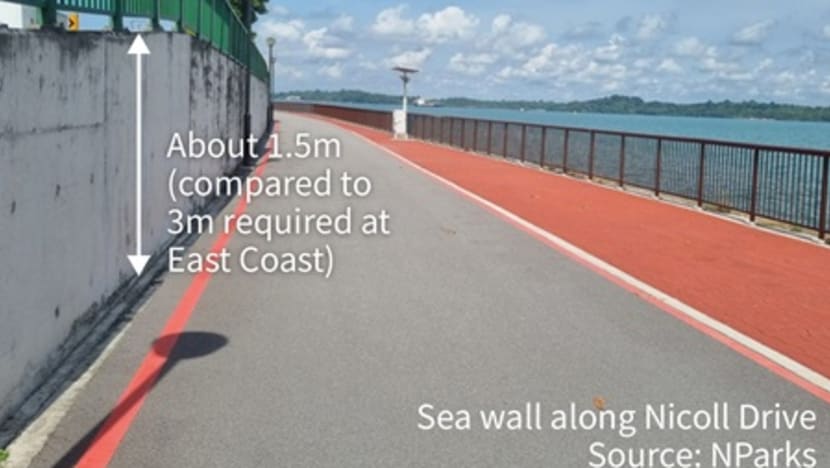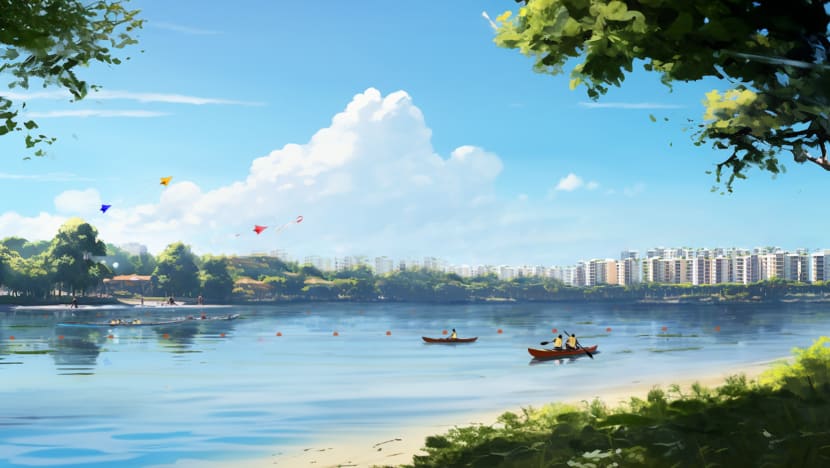Singapore to start technical studies into 'Long Island' off East Coast; reclaimed land could be twice the size of Marina Bay
The reclaimed "Long Island" will be around 800ha and will have a freshwater reservoir as well as new recreational and possibly even residential spaces.

This audio is generated by an AI tool.
SINGAPORE: Singapore is starting technical studies for a decades-long project to integrate coastal protection measures with future reclamation plans on its east coast.
The "Long Island" concept could involve around 800ha of reclaimed land - nearly the size of 1,142 football fields - and potentially provide more opportunities for waterfront living and jobs.
The reclaimed island, situated at East Coast Park's shoreline, would be about twice the land area of Marina Bay, and would create an enclosed waterbody in front of East Coast Park, transforming it into a freshwater reservoir.
Minister for National Development Desmond Lee announced the start of technical studies into the concept during a site-enhancement event at East Coast Park on Tuesday (Nov 28), where he planted a tree to kickstart a new 15km nature trail across the park.
He spoke about the need for coastal protection measures in low-lying Singapore.
"The concept of Long Island is to project coastal protection seawards, by reclaiming three new tracts of land, at a higher level, away from the current coastline. This will allow us to retain the existing East Coast Park, largely as it is," said Mr Lee, noting that people wanted to retain the unimpeded access to the waterfront.
The minister said Long Island would create opportunities for future generations of Singaporeans.
"They could build homes, create jobs, develop services and amenities that they need, and add around 20km of new coastal and reservoir parks, extending from the current East Coast Park. This will triple the length of the existing waterfront area along East Coast Park today."
Studies have projected a rise in mean sea level of up to 1m by 2100. Combined with the possible high tides and storm surges, the sea level could rise by 4m to 5m, threatening Singapore's shorelines.
Since 2021, Singapore has progressively conducted site-specific studies for different segments of its coastline. In September, it launched its first research centre dedicated to strengthening local capabilities and expertise in coastal protection and flood management.
Around one-third of Singapore is less than 5m above mean sea level including East Coast Park, a recreational area around the size of 180ha which sees 7.5 million visits annually, according to the National Parks Board.
The effects of high sea levels at the park - Singapore's largest park with a span of about 13km - are already being felt. In 2018 and in January this year, swathes of the park were flooded due to rain and high tide.
The authorities had studied the possibility of a 3m-high sea wall along the entire waterfront of East Coast Park, from Marina East to Tanah Merah.
These would be accompanied by 12 tidal gates and pumping stations along each of the existing outlet drains to keep the sea out and to pump rainwater out when heavy rain coincides with high tide.


Given the current use of East Coast Park for recreational activities, however, these measures would limit the current access to the beach and cause disruption to park users during constructions, noted Mr Lee.
The number of tidal gates and pumping stations needed would come at the expense of a substantial portion of existing park space - around 15 football fields if the 12 tidal gates and pumping stations were installed, said Mr Lee.
"In essence, this approach means that we implement coastal protection along the existing East Coast Park, but lose significant portions of the park and recreational use of the coastline," said the minister.
The authorities settled on Long Island as a more optimal solution. The idea was raised by Prime Minister Lee Hsien Loong during the National Day Rally in 2019, and showcased at the Urban Redevelopment Authority's (URA) long-term plan review exhibition last year.
Long Island would be reclaimed at a higher level to protect against sea level rise. The island would also create an enclosed waterbody, "preserving the waterfront character of the original East Coast Park", said Mr Lee.

The new freshwater reservoir would increase water supply and would also reduce the number of tidal gates and pumping stations to two for flood management in the East Coast area.
Apart from coastal protection measures, the reclaimed island could host additional recreational facilities, such as canoeing and dragon-boating on the reservoir.
Minister for Sustainability and the Environment Grace Fu said in a Facebook post after the announcement that the authorities had gathered views and suggestions through PUB-led dialogue Our Coastal Conversation before deciding on Long Island.
She added that the government has received innovative proposals from students through PUB’s ‘Living with the Rising Seas’ ideas competition earlier this year, which will be considered for Long Island.

The new island would add around 20km of new coastal and reservoir parks to the existing East Coast Park.
The government will be carrying out technical studies over the next five years to explore the feasibility of Long Island, said Mr Lee.
The studies, to begin in 2024, involve extensive environmental and engineering studies to see if the conceptual reclamation profile is feasible, and for the authorities to formulate innovative and cost-effective nature-based solutions.
At the same time, the authorities will also be engaging the public, such as nature and recreational interest groups and businesses in plans for Long Island.
After technical studies are completed, the authorities will engage the public on the design and masterplan for Long Island, said Mr Lee.
URA said in response to CNA's queries that as Long Island is a working title for the project, it will seek public feedback and ideas on the plans, including potential names.
















